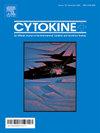Interleukin 17 producing T cell responses in human chronic trichinellosis-insight from a case study
IF 3.7
3区 医学
Q2 BIOCHEMISTRY & MOLECULAR BIOLOGY
引用次数: 0
Abstract
Introduction
We studied the cellular immune response in a patient infected since 10 months (along with other 51 people) during a trichinellosis outbreak caused by Trichinella spp.
Methods
A 46 years old female resulted serologically positive for trichinellosis. We isolated peripheral blood mononuclear cells (PBMCs) and incubated them with excretory/secretory antigens (ESA) of Trichinella spiralis (T1) or Trichinella pseudospiralis (T4) to produce antigen specific T cell lines and clones, analysed for the phenotype (T helper or cytotoxic cells), for their T4 or T1 antigens specificity and for their cytokine profile (IFNγ, IL-17A, IL-4) by flow cytometry, thymidine incorporation assay and ELISpot.
Results
The test performed using ESA from T1 or T4 has identified the species responsible for infection as T. pseudospiralis since the proliferative responses (evaluated by CFSE, Carboxyfluorescein succinimidyl ester, FACS analysis) was higher for T4 (72,8%) than T1 (23.6 %) antigen. The cell lines produced significant levels of IFNγ, IL-4 and IL-17A after stimulation. From the T cell line obtained in response to T1 ESA, as regards CD4 + cells, 12 % Th2, 22.8 % Th1, 6.6 % Th17, 6 % Th0, 2.2 % Th1/Th17 and 0.7 % Th2/Th17, were obtained. From the T1-specific TCL we generated 15 clones. From the TCL specific for T4 ESA, as regards CD4+, 15.2 % Th2, 27.1 % Th1, 3 % Th17, 10.3 %Th0, 1.9 % Th1/Th17 and 1 % Th2/ Th17 were obtained. From such TCL 4 clones were isolated, 1Th2, 1 Th1, 1 Th17, 1 Th1/Th17 and no Th0 nor Th2/Th17.
Conclusions
By cellular immunology techniques the species responsible of the infection resulted T. pseudospiralis, confirming the results previously obtained by serology. For the first time it was revealed in a human chronic infection the presence of Th17 cells.
人类慢性旋毛虫病中产生白细胞介素 17 的 T 细胞反应--一项病例研究的启示。
简介:我们研究了一名在由旋毛虫引起的旋毛虫病暴发中感染了 10 个月(以及其他 51 人)的患者的细胞免疫反应:我们研究了一名在由旋毛虫引起的旋毛虫病爆发期间感染了 10 个月的患者(以及其他 51 人)的细胞免疫反应:一名 46 岁女性的毛霉菌病血清学检测结果呈阳性。我们分离了外周血单核细胞(PBMCs),并将其与螺旋毛癣菌(T1)或假螺旋毛癣菌(T4)的排泄/分泌抗原(ESA)培养,以产生抗原特异性 T 细胞系和克隆、通过流式细胞术、胸腺嘧啶掺入试验和 ELISpot 分析表型(T 辅助细胞或细胞毒性细胞)、T4 或 T1 抗原特异性及其细胞因子谱(IFNγ、IL-17A、IL-4)。结果:使用 T1 或 T4 的 ESA 进行的检测确定了造成感染的物种为假丝酵母菌,因为 T4(72.8%)的增殖反应(通过 CFSE、羧基荧光素琥珀酰亚胺酯和 FACS 分析评估)高于 T1(23.6%)抗原。细胞系在受到刺激后会产生大量的 IFNγ、IL-4 和 IL-17A。从对 T1 ESA 有反应的 T 细胞系中获得的 CD4 + 细胞中,Th2 细胞占 12%,Th1 细胞占 22.8%,Th17 细胞占 6.6%,Th0 细胞占 6%,Th1/Th17 细胞占 2.2%,Th2/Th17 细胞占 0.7%。我们从 T1 特异性 TCL 中产生了 15 个克隆。从 T4 ESA 特异性 TCL 中获得了 15.2 % Th2、27.1 % Th1、3 % Th17、10.3 %Th0、1.9 % Th1/Th17 和 1 % Th2/Th17。从这些 TCL 中分离出 4 个克隆,1 个 Th2、1 个 Th1、1 个 Th17、1 个 Th1/Th17,没有 Th0 或 Th2/Th17:通过细胞免疫学技术,导致感染的物种是伪螺旋体,这证实了之前通过血清学获得的结果。在人类慢性感染中首次发现了 Th17 细胞的存在。
本文章由计算机程序翻译,如有差异,请以英文原文为准。
求助全文
约1分钟内获得全文
求助全文
来源期刊

Cytokine
医学-免疫学
CiteScore
7.60
自引率
2.60%
发文量
262
审稿时长
48 days
期刊介绍:
The journal Cytokine has an open access mirror journal Cytokine: X, sharing the same aims and scope, editorial team, submission system and rigorous peer review.
* Devoted exclusively to the study of the molecular biology, genetics, biochemistry, immunology, genome-wide association studies, pathobiology, diagnostic and clinical applications of all known interleukins, hematopoietic factors, growth factors, cytotoxins, interferons, new cytokines, and chemokines, Cytokine provides comprehensive coverage of cytokines and their mechanisms of actions, 12 times a year by publishing original high quality refereed scientific papers from prominent investigators in both the academic and industrial sectors.
We will publish 3 major types of manuscripts:
1) Original manuscripts describing research results.
2) Basic and clinical reviews describing cytokine actions and regulation.
3) Short commentaries/perspectives on recently published aspects of cytokines, pathogenesis and clinical results.
 求助内容:
求助内容: 应助结果提醒方式:
应助结果提醒方式:


